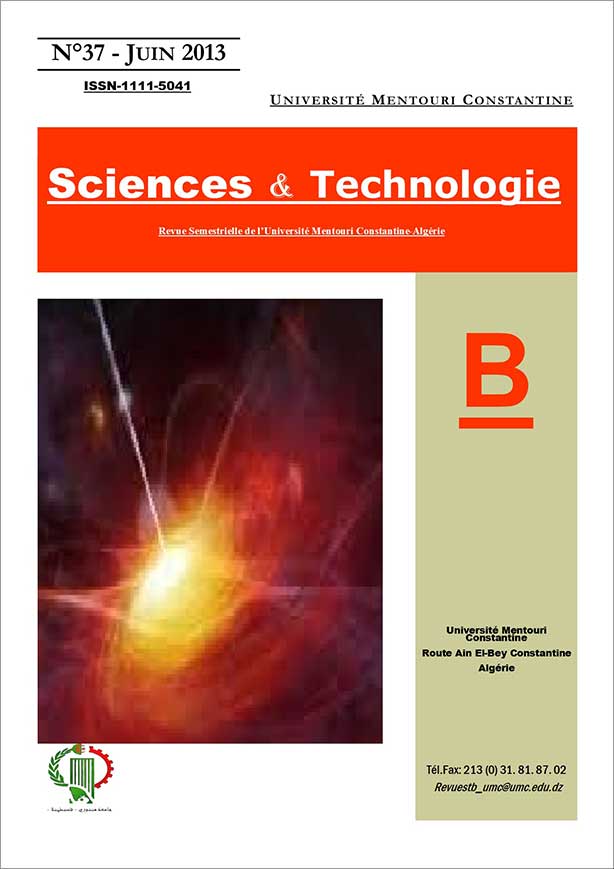ANALYSE DU COMPORTEMENT ELASTO-PLASTIQUE D’UN ASSEMBLAGE A BASE DE BOIS
Keywords:
Analyse élastoplastique, Assemblage broché-collé, Endommagement et rupture, AnsysAbstract
Le présent travail a pour but d’analyser le comportement à rupture par essais et le comportement élasto-plastique par simulation numérique (Ansys) d’un assemblage à base de bois broché – collé.
Trois séries d’assemblages brochés – collés ont été utilisés pour les essais à rupture : à base de hêtre (bois massif), de bois rouge et de bois blanc (bois résineux). Les résultats expérimentaux et de simulation nous ont permis :
- d’identifier et de localiser les premiers sites d’endommagement et d’amorçage,
- d’identifier les différents modes de ruptures,
- de définir le rôle de chaque élément de l’assemblage dans la résistance aux chargements appliqués.
- de comparer les résultats des essais de rupture et ceux de la simulation numérique.
References
A.M. Bozo (2002), Spatial variation of Wood composites, Thèse pour l’obtention du grade PhD, Washington state university.
Buffon (1740), Expériences sur la force du bois, Mémoires de l’Académie es Sciences.
Carlos G. Dávila (2001), Mixed-Mode Decohesion Elements for Analyses of Progressive Delamination, NASA Langley Research Center Hampton, VA University of Porto, Portugal. Paper AIAA-01-1486 42nd AIAA/ASME/ASCE/AHS/ASC Structures, Structural Dynamics and Materials Conference Seattle, Washington.
C.O. Cramer (1967), An analytical and experimental examination of wood tension joints having a large number of bolts, University of Wisconsin. PhD Thesis.
M.F.S.F. De Moura, J.P.M. Gonçalves (2000), A.T. Marques and P.M.S.T. De Castro, Prediction of Compressive Strength of Carbon-Epoxy Laminates Containing Delamination by Using a Mixed-Mode Damage Model, Composite Structures, Vol. 50, pp. 151-157.
A.J. DiNicola and S.L. Fantle (1993), Bearing strength of clearance fit fastener holes in toughened graphite/epoxy laminates, Composite Materials: Testing and Design Vol. 11, ASTM STP 1206, pp. 220-237.
A.M. Dodson (2003), The Effects of Row Spacing and Bolt Spacing in 6-Bolt and 4-Bolt Wood-to-Steel Connections. Washington state university.
D.V. Doyle and J.A. Scholten (1963), Performance of bolted joints in Douglas-fir, U.S. Department of agriculture, Forest Service, Forest Product Laboratory.
W.X. Fan and C.T. Qiu (1993), Load Distribution of Multi-Fastener Laminated Composite Joints, International Journal of Solids and Structures, Vol. 30, No. 21, pp.3013- 3023.
Z.W. Guan and P.D. Rodd (2000), A Three-Dimensional Finite Element Model for locally Reinforced Timber Joints made with Hollow Dowel Fasteners, Canadian Journal of Civil Engineering, 27, 785-797.
R. Hooke (1663), De Potentia Restituva, Royal Society.
K.W. Johansen (1949), Theory of Timber Connections, International Association for Bridge and Structural Engineering. Zurich, Switzerland.
S.H. Ju and R.E. Rowlands (2001), A Three-Dimensional Frictional Stress Analysis of Double-Shear Bolted Wood Joints, Wood and Fiber Science, 33(4), 550-563.
R.H. Kunesh and J.W. Johanson (1968), Strength of multiple – bolt joints: Influence of spacing an other variable, Forest Research Laboratory, Oregon State University.
C.J. Mettem and A.V. Page (1992), Load distribution in multi – fastener bolted joints in european whitewood glulam with steel sideplates, Ahus, Sweden.
M.A. McCarthy and C.T. McCarthy, Finite element analysis of the effects of clearance on single shear, composite bolted joints, Composites Research Centre Mechanical & Aeronautical Engineering Department, University of Limerick, Limerick, Rep. of Ireland.
D.M. Moses and H.G.L. Prion (1999), Bolted Connections in Structural Composite Lumber: Anisotropic Plasticity Model, Proceedings, Pacific Timber Engineering Conference, Rotorua, New Zealand, 2.92-2.99.
M. Patton-Mallory, S.M. Cramer, F.W. Smith and P.J. Pellicane (1997), Nonlinear Material Models for Analysis of Bolted Wood Connections, Journal of Structural Engineering, ASCE, 123(8), 1063-1070.
M.U. Rahman, Y.L. Chiang and R.E. Rowlands (1991), Stress and failure analysis of double bolted joints in Douglas Fir and Stika Spruce.
A.C. Schreyer (2002), Monotonic and cyclic behaviour of slender dowel – type fastener in wood – steel – wood connection, University of British Columbia, Canada.
G.W. Trayer (1932), The bearing strength of wood under bolts, U.S. Department of agriculture, Forest service, Forest Products Laboratory.
M. Yasamura, T. Murota and H. Sakai (1987), Ultimate properties of bolted joints in glued – laminated timber, Dublin, Ireland.
Downloads
Published
How to Cite
Issue
Section
License
Les auteurs publiant dans cette revue acceptent les termes suivants :- Les auteurs détiennent le droit d'auteurs et accordent à la revue
le droit de première publication, avec l’ouvrage disponible simultanément [SPÉCIFIER LA PÉRIODE DE TEMPS] après publication, sous la licence Licence d’attribution Creative Commons qui permet à d'autres de partager l'ouvrage en en reconnaissant la paternité et la publication initiale dans cette revue. - Les auteurs peuvent conclure des ententes contractuelles additionnelles et séparées pour la diffusion non exclusive de la version imprimée de l'ouvrage par la revue (par ex., le dépôt institutionnel ou la publication dans un livre), accompagné d'une mention reconnaissant sa publication initiale dans cette revue.
- Les auteurs ont le droit et sont encouragés à publier leur ouvrage en ligne (par ex., dans un dépôt institutionnel ou sur le site Web d'une institution) avant et pendant le processus de soumission, car cela peut mener à des échanges fructueux ainsi qu'à un nombre plus important, plus rapidement, de références à l’ouvrage publié (Consulter The Effect of Open Access).

